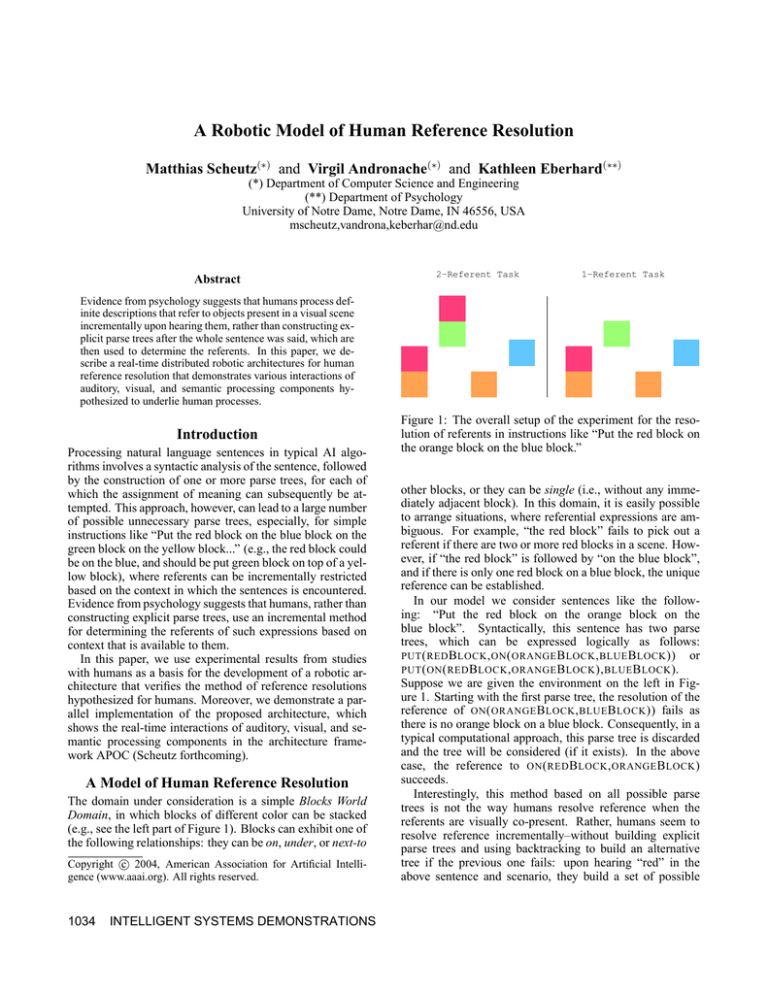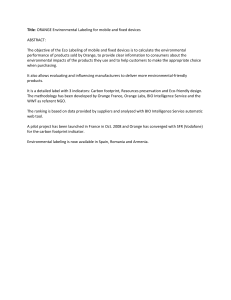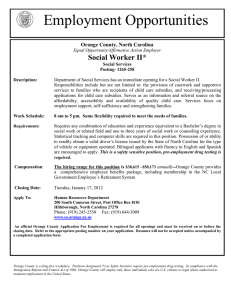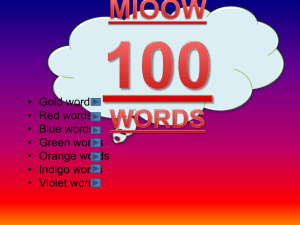
A Robotic Model of Human Reference Resolution
Matthias Scheutz(∗) and Virgil Andronache(∗) and Kathleen Eberhard(∗∗)
(*) Department of Computer Science and Engineering
(**) Department of Psychology
University of Notre Dame, Notre Dame, IN 46556, USA
mscheutz,vandrona,keberhar@nd.edu
Abstract
2−Referent Task
1−Referent Task
Evidence from psychology suggests that humans process definite descriptions that refer to objects present in a visual scene
incrementally upon hearing them, rather than constructing explicit parse trees after the whole sentence was said, which are
then used to determine the referents. In this paper, we describe a real-time distributed robotic architectures for human
reference resolution that demonstrates various interactions of
auditory, visual, and semantic processing components hypothesized to underlie human processes.
Introduction
Processing natural language sentences in typical AI algorithms involves a syntactic analysis of the sentence, followed
by the construction of one or more parse trees, for each of
which the assignment of meaning can subsequently be attempted. This approach, however, can lead to a large number
of possible unnecessary parse trees, especially, for simple
instructions like “Put the red block on the blue block on the
green block on the yellow block...” (e.g., the red block could
be on the blue, and should be put green block on top of a yellow block), where referents can be incrementally restricted
based on the context in which the sentences is encountered.
Evidence from psychology suggests that humans, rather than
constructing explicit parse trees, use an incremental method
for determining the referents of such expressions based on
context that is available to them.
In this paper, we use experimental results from studies
with humans as a basis for the development of a robotic architecture that verifies the method of reference resolutions
hypothesized for humans. Moreover, we demonstrate a parallel implementation of the proposed architecture, which
shows the real-time interactions of auditory, visual, and semantic processing components in the architecture framework APOC (Scheutz forthcoming).
A Model of Human Reference Resolution
The domain under consideration is a simple Blocks World
Domain, in which blocks of different color can be stacked
(e.g., see the left part of Figure 1). Blocks can exhibit one of
the following relationships: they can be on, under, or next-to
c 2004, American Association for Artificial IntelliCopyright gence (www.aaai.org). All rights reserved.
1034
INTELLIGENT SYSTEMS DEMONSTRATIONS
Figure 1: The overall setup of the experiment for the resolution of referents in instructions like “Put the red block on
the orange block on the blue block.”
other blocks, or they can be single (i.e., without any immediately adjacent block). In this domain, it is easily possible
to arrange situations, where referential expressions are ambiguous. For example, “the red block” fails to pick out a
referent if there are two or more red blocks in a scene. However, if “the red block” is followed by “on the blue block”,
and if there is only one red block on a blue block, the unique
reference can be established.
In our model we consider sentences like the following: “Put the red block on the orange block on the
blue block”. Syntactically, this sentence has two parse
trees, which can be expressed logically as follows:
PUT ( RED B LOCK , ON ( ORANGE B LOCK , BLUE B LOCK )) or
PUT ( ON ( RED B LOCK , ORANGE B LOCK ), BLUE B LOCK ).
Suppose we are given the environment on the left in Figure 1. Starting with the first parse tree, the resolution of the
reference of ON ( ORANGE B LOCK , BLUE B LOCK )) fails as
there is no orange block on a blue block. Consequently, in a
typical computational approach, this parse tree is discarded
and the tree will be considered (if it exists). In the above
case, the reference to ON ( RED B LOCK , ORANGE B LOCK )
succeeds.
Interestingly, this method based on all possible parse
trees is not the way humans resolve reference when the
referents are visually co-present. Rather, humans seem to
resolve reference incrementally–without building explicit
parse trees and using backtracking to build an alternative
tree if the previous one fails: upon hearing “red” in the
above sentence and scenario, they build a set of possible
referents P R(red), which at this point contains two red
blocks. Since the set is not a singleton, the subsequent
words are taken to specify constraints on P R and thus to
belong to the same referential phrase. Hence, upon hearing
“on” a constraint will be instantiated that limits the referents
in P R(red) based on the set P R(orange), which will be
formed upon hearing “orange”. Since the newly formed set
P R(on(red, orange)) is a singleton, the referent, which is
the argument for “put” has been established to be the single element in P R(on(red, orange)). Hence, subsequent
words are not taken to be part of the definite description anymore.
Now consider a situation depicted on the right in
Figure 1, where the referent of “the red block” is
uniquely specified. Taking again the above sentence
“Put the red block on the orange block on the blue
block”, a classical parser would produce the unique parse
PUT ( ON ( RED B LOCK , ORANGE B LOCK ), BLUE ).
Hence,
there is no ambiguity as to what the sentences seems to ask
for. Yet, for human subjects, this sentences causes problems,
because according to the above described algorithm reference to a unique object is established upon hearing “red”, at
which point “on” is taken to belong to “put”. Consequently,
the second argument of “put”, i.e., the location at which to
place the red block, is taken to be the referent of “orange”.
Although this is a set with two possible referents, the precondition of “put”–that no block can be on top of a target of the
put action–eliminates the orange block underneath the red
block, and thus reduces the set of possible referents for “orange” to a singleton (namely, the orange block on the right).
Hence, at this point, all the information is present that allows subjects to carry out the put action. Yet, the sentence
has not finished, but rather the additional, but seemingly superfluous phrase “on the blue block” is heard. At this point,
human subjects attempt to make sense of that phrase. While
some subjects interpret it as another put action (after having
put the red block from the orange block on the left onto the
orange block on the right), others simply ignore it.
Model and Architecture
Several psychological experiments have established the
above effect (e.g., (Tanenhaus et al. 1995)) and suggest the
above algorithm described for the human behavior. In particular, the assumption is that resolving reference is an incremental process that does not depend on prior established
parse trees, which, if a conflict is encountered, are discarded
to build alternative trees (if possible). The architecture that
implements the above algorithm is depicted in Figure 2.
Each rectangle indicates a component type, whose function is indicated by its label. While some types only have
one instance in the virtual machine (e.g., speech recognition), others can have multiple ones (e.g., blob tracking). For
space reasons, we can only briefly sketch the functionality of
the architecture.
Lexical items are processed in real-time using Sphinx
2 (see HTTP :// WWW. SPEECH . CS . CMU . EDU / SPHINX /). The
recognized words are passed to the word analysis node,
which ensures that only one word at a time is processed (this
node effectively “wraps” the Sphinx system within APOC).
Referent
Analysis
Conceptual
Frames
Spatial
Relation
Analysis
Syntax
Analysis
Lexicon
Compound
Object
Tracking
Visual
Attention
Word
Analysis
Blob
Tracking
Visual
Search
Speech
Recognition
Color Blob
Detection
Camera
Control
Figure 2: A high-level view of the components employed in
the architecture used in the reference resolution task.
The syntactic analysis looks up the word in a lexicon and either initiates a referential analysis (if a referential expression
is expected), or instantiates the associated conceptual frame,
if it exists (e.g., as in the case of “put”), which will pass control to the referential analysis to obtain its arguments. The
referential analysis influences the visual search, which will
look for items that match the meaning of the expression built
so far. This process involves the instantiation of trackers that
lock onto recognized objects in the visual scene, from which
more complex trackers can be built based on relational, spatial properties obtained from spatial analysis (e.g., “on”).
The visual attention node focuses on one of possibly many
trackers (in the cases considered here this is always the one
closest to the last focus of attention). Complex trackers, in
this architecture, are the “meaning” of relational terms that
denote relationship among primitive objects (such as color
blocks) as represented by instantiated trackers. When a referent has been uniquely determined, the referential analysis passes control back to the instantiated conceptual frame,
which then either expects more arguments, or, if complete,
triggers an action (not depicted here). During the whole process, all components are concurrently active, and the camera
is moving, if necessary, in such a way as to keep all trackers
within the camera’s view. While all components could run
on separate computers, in the experimental tests the whole
architecture was run autonomously on a ActivMedia Pioneer
Peoplebot.
References
Scheutz, M. (forthcoming) “APOC - An Architecture
Framework for Complex Agents.” In Darryl Davis. Visions
of Mind. Idea Group Inc.
Tanenhaus, M. K., Spivey-Knowlton, M. J., Eberhard, K.
M., & Sedivy, J. C. 1995 Integration of visual and linguistic
information in spoken language comprehension Science,
268, 1632-1634.
INTELLIGENT SYSTEMS DEMONSTRATIONS 1035




